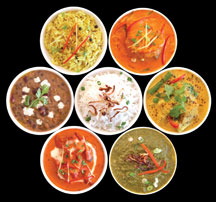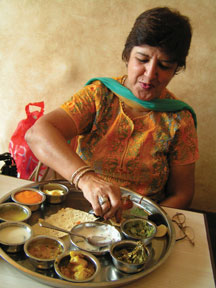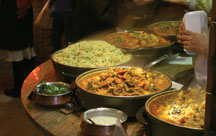India
My Indian Binge

A love poem to India's gourmet delights.
 I thought I had died and gone to vegetarian heaven. I thought I had died and gone to vegetarian heaven.
The waiters were bringing trays after trays of intricate snacks – kebabs, koftas, cutlets, tikkis – all hundred percent vegetarian and all delicious, with unusual flavorings and a seductive mélange of mushrooms, spinach, corn and a host of lentils. The occasion was a dinner thrown at the fabulous farmhouse of Mukta Nandini Jain, a prominent socialite. This beautiful home on the Mehrauli Gurgaon road was aglow with candles and perfumed with huge vats of aromatic rajnigandha blossoms and the striking art of many emerging artists. On this 45 acre property is the Sanskriti Museum of Everyday Art, Indian Terracotta and Textiles for the preservation of indigenous craftsmanship, founded by the noted art collector O.P. Jain. This amazing museum encompasses a lifetime’s collection of folk arts from all parts of India and is a story in itself. The large lawns had been laid with tables and a buffet that snaked around the entire circumference – and what a feast it was. The hosts are of Jain heritage so all the food was completely vegetarian, almost 30 regional delights from different parts of India. What could you try and what could you leave out? The rich offerings included everything from intricate main courses to biryanis, vegetables and dals. There were scores of different flat breads, puris and rotlas. The desserts laid out under the stars were delectable – from gulab jamuns to malpuras to hot jalebis served with kulfi. The foreigners and NRIs at the event seemed quite overwhelmed by this feast for over a 100 guests, but several of the locals seemed quite blasé, commenting they went to such parties several times a week. For them, these culinary fireworks seemed a part of regular life. Well! Forget about India Shining or India Rising – it’s all about India Eating! My four weeks in India were all about eating, eating and eating. I was a visitor so it’s understandable that I was taken out to eat, but why was the rest of India binging as if there was no tomorrow?
A bite at McDonalds, a shopping spree in a large mall to pick up some Levis jeans and then catching a movie at a multiplex. Sounds like a weekend in New York, Atlanta or Texas? Well no, this is a typical weekend pastime in Mumbai or New Delhi! Welcome to a new India that is turning more and more like America with its barrage of fast food places from Subway to Pizza Hut to Dominos. But interestingly each of these American chains has been localized. The McDonald’s menu features McAloo Tikki Burger, Wrap Paneer Salsa, Vegetarian Pizza McPuff and of course, McVeggie Burger. For those with unhappy memories of beef fat used in fries, this is a whole new experience with 100 percent vegetarian food; even the mayonnaise is eggless! “We ensure that the cooking area for vegetarian products is visibly segregated from the other sections and separate set of equipments is used for cooking them,” touts the McDonald menu. “So the next time you think of delicious vegetarian food, rush straight to your nearest McDonald’s Family Restaurant.” “Hungry kya?” is the trademarked clarion call of Dominos Pizza and it has its own Indian features – a Peppy Paneer Pizza and one actually called Khasta Kebab Pizza with onions and vegetarian kebabs as toppings. Now when are they going to introduce all that in the U.S. for us Indian American vegetarians? The coffee shops are another innovation. You can walk into markets in upscale neighborhoods and get a light meal and the coffee of your choice at Baristas or the scores of other coffee places, all particularly popular with the young and affluent. Want a slice of cheesecake or a brownie? It’s all there. International food has come to India in a big way and I ate a superb Chinese meal at Lee’s Garden, a Mediterranean meal at Tabula Rasa, and a Greek meal at It’s Greek to Me. The range of cuisines is mind boggling at five stars hotels, but the telling thing is that I had all these meals in small neighborhood restaurants or in the malls. Foreign tastes are now all the rage. The malls again are really something else. You feel like Alice through the Looking Glass. It’s a surreal feeling to drive through potholed roads with all the traffic drama of Indian streets into one of the huge new shopping malls, which are a virtual forest of name brands including Tommy Hilfiger, Ferragamo, Body Shop, Dior, Escada, DKNY and Cartiers. There’s even a Mark and Spencer from the UK.
In the same mall in Gurgaon, I found what’s become a new addiction for me – roasted snacks from Farsaan. If you crave dal moth, chevdas and other fried snacks, you know it’s a no-no for you, calorie wise. Now come health roasted snacks without the oil, but all the spices and flavorings. The fresh snacks are sold by the pound and there are samplings of all the delights. You end up almost having a full meal by the time you’ve tried the jars and jars of different snacks. I ended up buying bags of matar, moong, and chana chor, and a diet navratan( mix, highly addictive lentil bites to help keep me at the computer in New York – without the guilt. They also had good-for-you soy sticks and chips, but with intriguing spices so you forget they are meant to be good for you. If you can’t resist Delhi daal moth, try the roasted low-calorie version. Bombay had a similar shop, just as popular, called Camy, where its diet snacks include whole wheat versions like roasted methi puris and roasted samosas, with just 0.74 percent fat calories. The products are manufactured by Camy Wafer, using a special roasting process. Bombay was great for the large number of vegetarian options and the thalis are a special part of the food scene. There was a lot of buzz about the opening of the newest branch of Rajdhani, a place where you can eat till you drop and waiters scurry forth with endless containers of vegetables, dal, hot puris and aam ras – 32 offerings in all. Eat as much as you want for Rs 100 – that’s about $2.50! And that includes drinks. Order a big glass of chhaas and all hrefills are on the house. The value of these inexpensive meals is quite amazing. On another day I went to Govinda, the restaurant run by Iskcon in Bombay. Situated in Chowpatty right next to the beautiful white Sri Sri Radha Gopinath Mandir, this cozy restaurant has an aura of calm with beautiful Krishna paintings showing the life of the Blue God. In one niche on the wall there are scores of images of Krishna lit up. Soft bhajans played as the food was brought out. What can be better than “karma-free, spiritually sanctified preparations”? The menu included an interesting mix of cuisines, including a huge tricolor dosa, which was quite a showstopper. What I look about India is how all cuisines are embraced at one go. Govinda offers pure Jain, Punjabi, Maharashtrian, South Indian, Gujarati, Chinese – and Italian. Where would you eat pizzas named Gopal’s Garden and Govinda’s Supremo cooked in a Pavesi Forni Italian brick oven which cooks nine 12 inch pizzas at a time? And everywhere there were the desserts – kulfis, seeras, halvas, gulab jamuns, rabris, ras malais and jalebis. And mixing East and West they also had added cakes, ices and pastries. At Govinda they had special handmade ice-creams in unusual flavors. The very fact that people can walk and not waddle after all these eats is a credit to the people of India!
That people have become diet conscious is obvious from the “zero carb” blurb on dishes like moong daal chillas and vitamin bhel, which was not only zero carb but also high protein. The drinks included such thirst quenchers as sugar cane juice, jal jeera nariyal pani and masala soda. As for desserts, who can pass up garam mohanthaal or kesar jalebi? There were hand-churned ice-creams in exotic flavors, like gulkund, roasted almond and sugar free varieties of badam pista and anjeer almond. If eating out was a temptation, eating in was no less so. At my sister’s place the cook is famous for his achari parathas – wonderful flatbreads with fillings of sabzi and achar and rolled tightly like a kati roll. It was hard to stop at one. Other delicious home cooked meals included bhugal peas and tande ke rotis, paneer in methi and a variety of simple, heavenly dals. Eating at the homes of friends was an experience in creativity and offbeat tastes – one served a complete Mongolian meal with chefs taking your selected raw ingredients, mixing them with a variety of sauces on the steaming grill and handing you a delicious platter embedded with peanuts, noodles and other ingredients. At another home I got typical Indian food, but with falafels, hummus and kebabs bought from a neighborhood Middle Eastern store. This is all becoming very Times Square! Even going to the movies was all about eating! I saw three movies in three weeks and each meant delicious planning. The new multiplexes house stores and restaurants. So one day we ate a traditional South Indian meal in the complex before popping in to see Hattrick and on an another day we feasted on sandwiches, cakes and cold coffee at a nearby Cosmo coffee shop after seeing the amusing Akshay Kumar starrer Namastey London. Amazingly the whole of India seems to be out at the movies, and shopping and eating, at any given day or time. Or perhaps it’s just the fact of there being a billion people. The malls, restaurants and multiplexes are always teeming with people. Eating seems to be a national pastime – no, a national obsession. The chaat places and sweet houses are always packed. Restaurants, be they Chinese or Thai or Indian, all seem to be doing rip-roaring business. And yes, you have Baskin Robbins too. Can you imagine the toll on the national waistline? Eating is a religion in a culture that believes that a guest is God. You are treated even on short hello-and-goodbye visits to friends or friends of friends. Indians are a hospitable lot and it’s always fun to see what people whip up for sudden guests, from large chilled tumblers of pomegranate juice to platters of samosas and freshly made chocolate cake. You can never leave a home without some food or drink passing your lips. Then there’s the whole club culture in India and that’s probably something we’ve got the British Raj to thank for. Built on the premises of snobbery and an elite private world, the clubs are still flourishing and it is intriguing to be let into this exclusive world where not everyone can get in. Everywhere I went, people with signing privileges were entertaining in clubs where food and drink is inexpensive and the setting is informal. In Delhi, the Delhi Golf Club, the Gymkhana, the India International Center, Habitat Center were some of the places I visited. In Bombay, it was the Cricket Club of India, the Radio Club and the United Service Club, also known as the US Club. In fact, three gymkhana clubs stand cheek by jowl – the Hindu Gymkhana, the Christian Gymkhana, and the Parsi Gymkhana! Clubs are great places to have traditional meals, Chinese or continental food. Drink a naryal pani or a lemon soda – it’s the Mumbai thing to do. Sit at the Radio Club and you see the ships on the ocean and a big fat moon creeping up over the night sky. Nothing like munching on bhel and watching people go by. At the National Sports Club of India (NSCI), food is so much a part of the picture that they actually have a small supermarket on the premises and a cake shop, which sells pound cake, cheesecake and brownies. Throughout the evening as people played tambola – six games at a time – they feasted on Chinese food, pakoras, kebabs and whatever else took their fancy. Food is a part of the fabric of daily life and there are small treats from temples and gurudwaras, food shared by communities, a benediction of the Gods. At a local satsang, friends shared a parshad of Sindhi sail chappatis, a traditional dish in which flatbreads are cooked in a mint sauce. Each temple seems to offer its own unique parshad. At a dinner party in Bombay, I encountered an Indian couple from Dallas. We headed out into the elevator together and the husband promptly pulled out a paper horn of Bombay roasted peanuts, the kind you get on Marine Drive. An addictive snack from childhood days, we all greedily shared it in the elevator. It seemed to have the sun, the sea and salt of Marine Drive embedded in it. Such is the power of favorite foods, undulled by the passing of years. On my flight from Delhi to Bombay, just as we were about to land, I spotted a huge orange setting sun in the sky – round as a perfect syrupy gulab jamun – and then it seemed to disappear. It is surreal, but everything in India reminds me of food. I wanted to swallow India whole, all the aromas, the spices and textures, but as time ran out and my flight date to the U.S. loomed, I settled instead for delicious memories and some home-made pickles instead. As I boarded the flight, I brightened up a bit – there was still that one last Indian meal on Air India! |

 Whether it was five star hotels, mid-range restaurants, dhabas, pushcarts in the bazaar, clubs, fast food places, coffee houses or chaat places, be it lunch or dinner, weekend or weekday, they were all packed and bustling. At Sagar, a popular dosa restaurant, the waiting line snaked outside almost as large as a procession. The three-story restaurant was completely packed.
Whether it was five star hotels, mid-range restaurants, dhabas, pushcarts in the bazaar, clubs, fast food places, coffee houses or chaat places, be it lunch or dinner, weekend or weekday, they were all packed and bustling. At Sagar, a popular dosa restaurant, the waiting line snaked outside almost as large as a procession. The three-story restaurant was completely packed.  In these malls you find scores of western eateries and fast food places, but nobody is willing to give up the delights of desi khana. At the Mega Mall in Gurgaon, we ate at Khaja Chowk, a restaurant owned by Vikram Nair, director Mira Nair’s brother. The atmospheric restaurant has a good old phut phut or Indian auto rickshaw planted right in front and the food is lip-smackingly good. The menu included some talking point items such as Whiskey ki Kulfi Matke Mein (Whiskey Kulfi in a clay pot) with a mix of whiskey, honey and aniseed.
In these malls you find scores of western eateries and fast food places, but nobody is willing to give up the delights of desi khana. At the Mega Mall in Gurgaon, we ate at Khaja Chowk, a restaurant owned by Vikram Nair, director Mira Nair’s brother. The atmospheric restaurant has a good old phut phut or Indian auto rickshaw planted right in front and the food is lip-smackingly good. The menu included some talking point items such as Whiskey ki Kulfi Matke Mein (Whiskey Kulfi in a clay pot) with a mix of whiskey, honey and aniseed. Soam was another pure vegetarian restaurant near the Babulnath Temple in Chowpatty, serving inexpensive regional dishes on tablemats woven out of banana leaves. The dishes included such little known delicacies, at least to me, as kand na chilla and bhajra methi dhebra with luanji. Interestingly, nachos and cheese was a staple along with Jain, Gujarati and South Indian dishes!
Soam was another pure vegetarian restaurant near the Babulnath Temple in Chowpatty, serving inexpensive regional dishes on tablemats woven out of banana leaves. The dishes included such little known delicacies, at least to me, as kand na chilla and bhajra methi dhebra with luanji. Interestingly, nachos and cheese was a staple along with Jain, Gujarati and South Indian dishes!